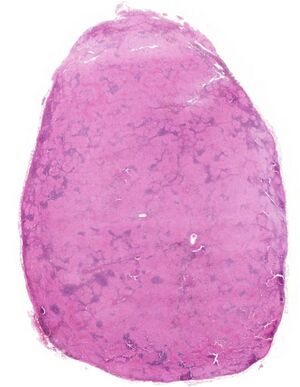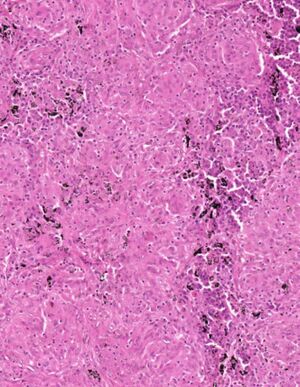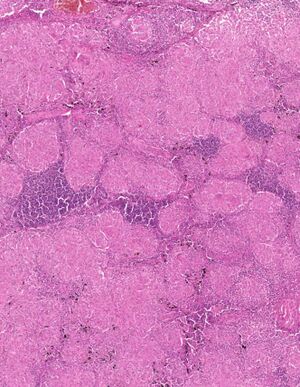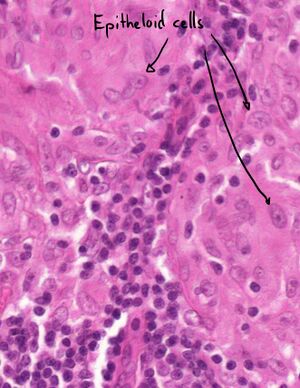29. Sarcoidosis in lymph node: Difference between revisions
(Created page with "'''Staining''': HE '''Organ''': Lymph node '''Description''': The whole slide is made up of mainly eosinophilic parts, with some basophilic tissue in between. Black pigment can be seen in some regions. '''Diagnosis''': Sarcoidosis '''Causes''': * Unknown cause '''Theory''': See also macropreparation 32 and slide 30. The basophilic tissue is the remnant on the normal lymphoid tissue that lymph nodes are comprised of. The eosinophilic rest of the slide is made up...") |
No edit summary |
||
| (One intermediate revision by the same user not shown) | |||
| Line 1: | Line 1: | ||
'''Staining''': HE | [[File:Sarcoidosis in lymph node overview.jpg|thumb|Overview of the slide]]'''Staining''': HE | ||
'''Organ''': Lymph node | '''Organ''': Lymph node | ||
| Line 15: | Line 15: | ||
'''Theory''': | '''Theory''': | ||
See also macropreparation 32 and slide 30. | See also macropreparation 32 and slide 30. The basophilic tissue is the remnant on the normal lymphoid tissue that lymph nodes are comprised of. The eosinophilic rest of the slide is made up of granulomas. These granulomas are “hard” because they have no necrotic centre. Not many giant cells can be seen. These granulomas are mostly made up of epithelioid cells. We can know that this lymph node is from the lung because we can see anthracosis.[[File:Sarcoidosis in lymph node anthracosis.jpg|thumb|Anthracosis|left]] | ||
[[File:Sarcoidosis in lymph node lymphoid tissue.jpg|thumb|The dark spots are lymphoid tissue. The eosinophilic spots are the granulomas.]] | |||
The basophilic tissue is the remnant on the normal lymphoid tissue that lymph nodes are comprised of. The eosinophilic rest of the slide is made up of granulomas. These granulomas are “hard” because they have no necrotic centre. | |||
Not many giant cells can be seen. These granulomas are mostly made up of epithelioid cells. | |||
We can know that this lymph node is from the lung because we can see anthracosis. | |||
[[File:Sarcoidosis in lymph node anthracosis.jpg | |||
[[File:Sarcoidosis in lymph node lymphoid tissue.jpg | |||
[[File:Sarcoidosis in lymph node epithelioid cells.jpg|center|thumb|Epithelioid granulomas]] | [[File:Sarcoidosis in lymph node epithelioid cells.jpg|center|thumb|Epithelioid granulomas]] | ||
[[Category:Pathology 1 - Histopathology slides]] | [[Category:Pathology 1 - Histopathology slides]] | ||
Latest revision as of 12:01, 5 July 2024

Staining: HE
Organ: Lymph node
Description:
The whole slide is made up of mainly eosinophilic parts, with some basophilic tissue in between. Black pigment can be seen in some regions.
Diagnosis: Sarcoidosis
Causes:
- Unknown cause
Theory:
See also macropreparation 32 and slide 30. The basophilic tissue is the remnant on the normal lymphoid tissue that lymph nodes are comprised of. The eosinophilic rest of the slide is made up of granulomas. These granulomas are “hard” because they have no necrotic centre. Not many giant cells can be seen. These granulomas are mostly made up of epithelioid cells. We can know that this lymph node is from the lung because we can see anthracosis.



